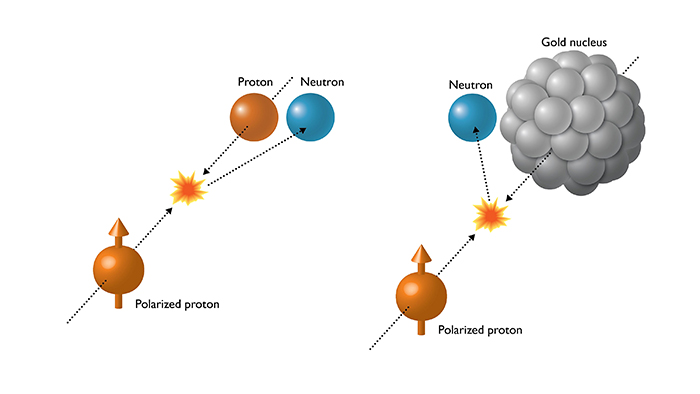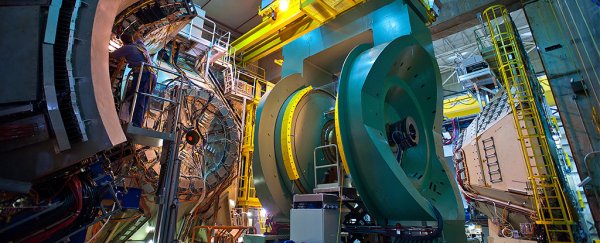Physicists have observed some weird atomic collision problems as particles failed to bounce off each other in the way science predicts they should.
But with some new work that helps to explain what's going on, they may just have found the key to understand some very complex particle physics.
A new study explains how the neutrons produced when a spinning proton hits another particle can spin off in opposite directions, depending on the mass of the proton or nucleus it's colliding with.
And according to the international team of researchers, it could help us learn more about other high energy particle collisions, such as the ones that occur when cosmic rays from outer space collide with the particles of Earth's atmosphere.
 Changing spin. (Brookhaven National Laboratory)
Changing spin. (Brookhaven National Laboratory)
"What we observed was totally amazing," says one of the team, physicist Alexander Bazilevsky from Brookhaven National Laboratory in New York.
"Our findings may mean that the mechanisms producing particles along the direction in which the spinning proton is traveling may be very different in proton-proton collisions compared with proton-nucleus collisions."
The researchers were using the Relativistic Heavy Ion Collider (RHIC) at the Brookhaven lab, the only collider in the world that can properly control the polarisation or spin direction of colliding protons.
It was way back in 2001 that the RHIC first demonstrated the tendency for proton-to-proton collisions to produce neutrons that veered off to the right, as long as the spin was kept in the same direction.
This new study looked at how those collisions and neutrons were altered when nuclei of different sizes were introduced.
When spinning protons met larger gold nuclei, not only did neutrons go off at a sharper angle, they went off to the left instead of the right, the researchers report.
It's almost like having a spinning billiard ball bounce off in one direction when it hits a ball of the same size, but then go in another direction when it hits a larger ball, even though the original spin is going the same way.
"We anticipated something similar to the proton-proton effect, because we couldn't think of any reasons why the asymmetry could be different," says one of the researchers, physicist Itaru Nakagawa from the RIKEN laboratory in Japan.
That variation seems to be down to the larger positive electric charges produced by the larger nuclei, suggest the researchers, changing the electromagnetic interaction between the two colliding particles to produce a different end result.
As the size of the particle being hit increases, so its electromagnetic force takes a larger role in the interaction, eventually flipping the directions of the neutrons being produced by the impact.
"In the particle world, things are much more complicated than the simple case of spinning billiard balls colliding," explains Bazilevsky. "There are a number of different processes involved in particle scattering, and these processes themselves can interact or interfere with one another."
More research and data analysis is now required to understand how the different variables of the particle smash can contribute to different end results. Eventually the work is going to be extended to look at the effects on particles other than neutrons too.
Further down the line, the researchers are hoping to solve the mystery of where this asymmetrical traverse spin comes from in the first place – something that scientists have been puzzling over since the 1970s.
If the team can run experiments with nuclei of different types of sizes, and the results match the calculations they've made from these initial findings, then we're a big step closer to understanding how this game of particle billiards plays out.
"If we observe exactly the asymmetry we predict based on the electromagnetic interaction, then this becomes very strong evidence to support our hypothesis," says Nakagawa.
The research has been published in Physical Review Letters. You can also see the team explain the findings in the video below:

